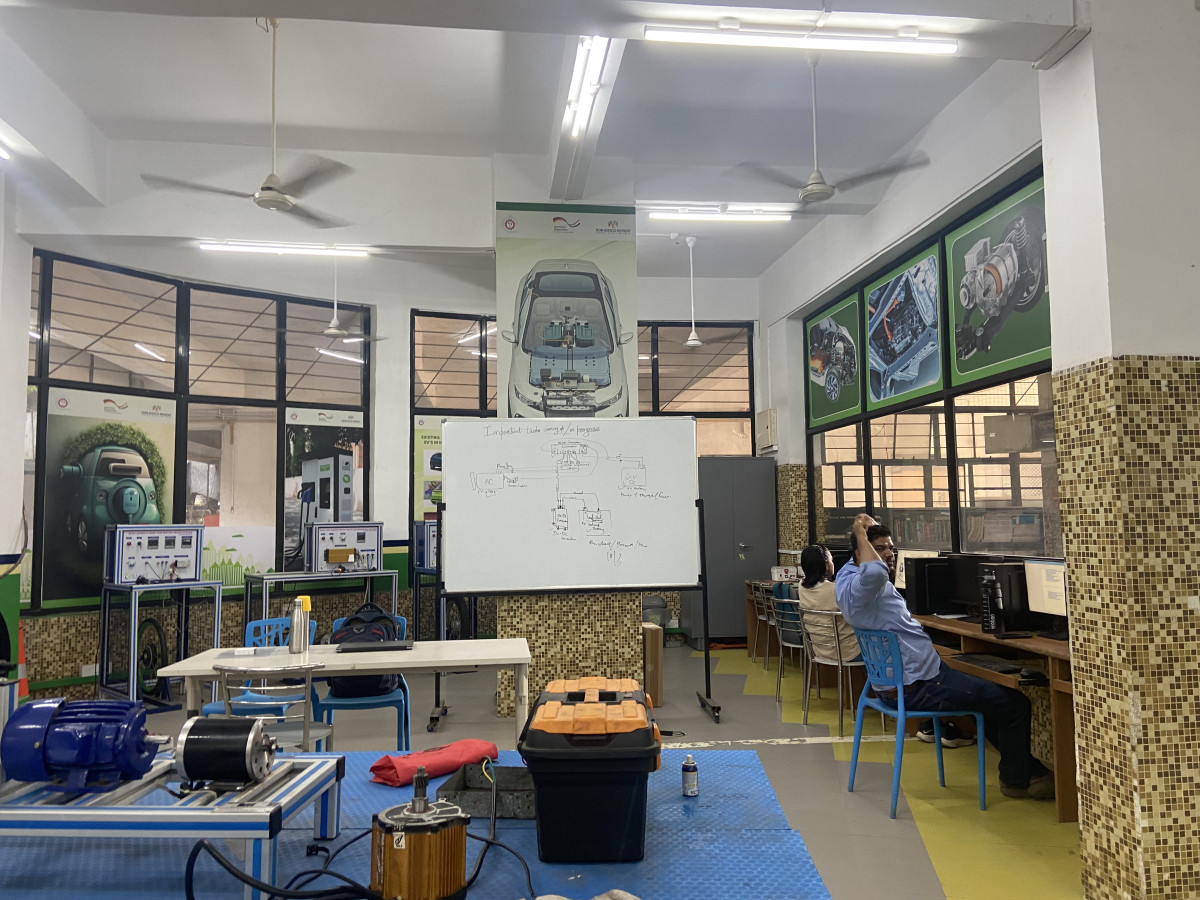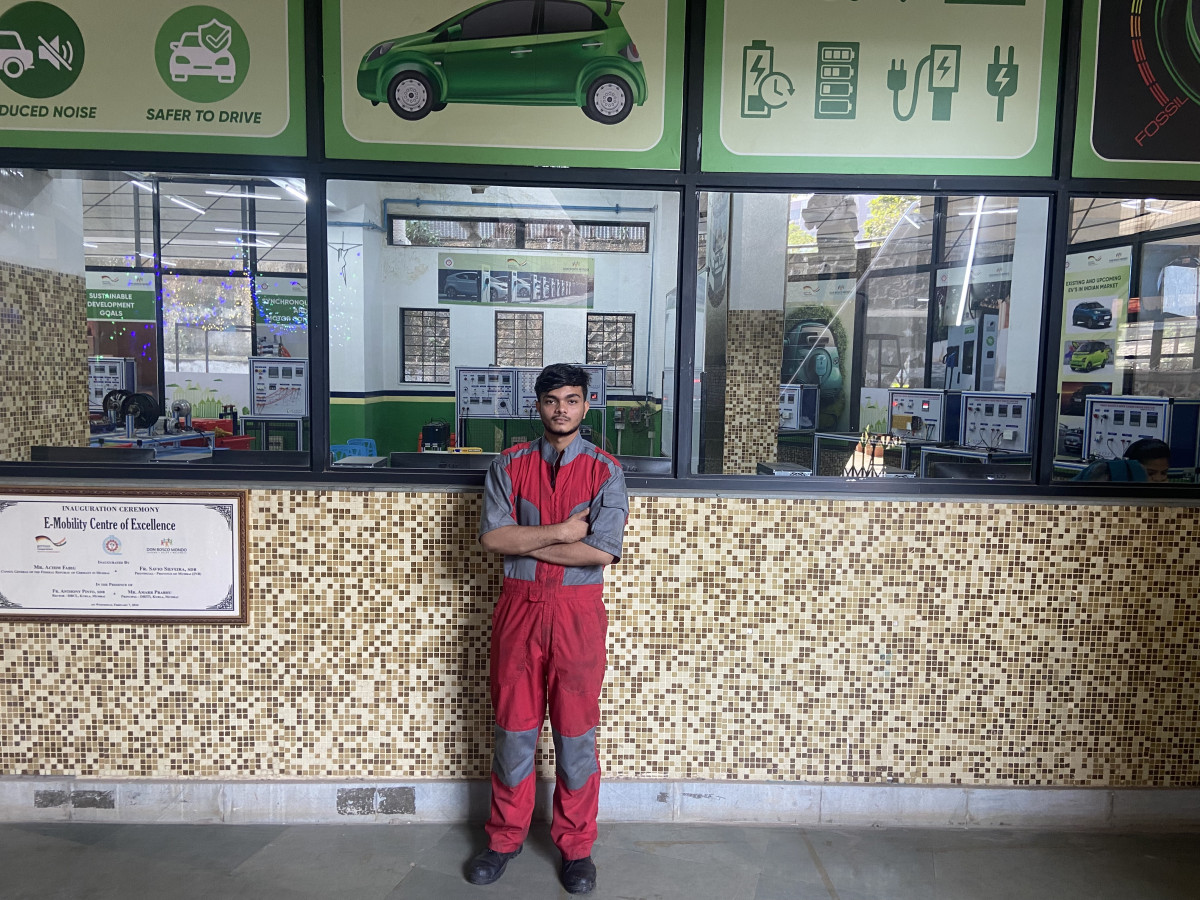Germany and India join forces to bridge the green skills gap – but youth might not engage
Since he was a child, Mohammad Atif Salim Khan watched his father lug a pile of plastic and jute wicker mats on his shoulder, selling them door to door in a central Mumbai suburb, returning home every evening with his back aching. Atif hoped for his career to be vastly different: he wished to work with cars, often playing a solo game of spotting the latest models on Mumbai’s busy roads on his walk back from school.
The 20-year-old is now learning German, and has his eyes on the “land of Porsche, Audi and BMW”. He learned to fix both traditional cars and electric vehicles, his aspiration is made possible by a new collaboration between India and Germany to build a green workforce for the future climate-friendly economy.
Atif is part of what many leaders hope will be a solution to a growing problem: a shortage of skilled labour to carry out the transition.
The global demand for green talent grew twice as quickly as supply between 2023 and 2024—with demand increasing by 11.6% and supply by 5.6%, according to the business-focused social network LinkedIn’s Global Green Skills Report 2024.
The report predicted that by 2030, “one in five jobs will lack the green talent to fill it” and by 2050, “this gap will balloon to one in two jobs”.
India, the world’s most populous nation and home to the largest number of people in the working age group, is seen as a fix to the skills problem.
Green skills collaboration
“Countries in the Global North are increasingly recognising that labour shortages are a huge bottleneck that they need to solve to meet their climate goals,” Samuel Huckstep of the Center for Global Development (CGD) said.
This includes Germany, whose ageing population is steadily widening the skilled shortage gap. Experts estimate the country will require an additional 350,000 skilled workers for its energy transition by 2030 in order to plan, build and operate renewable power and hydrogen production facilities. The country also faces shortages in its railway sector, as half of the operational workers are expected to retire by 2030.
As a result, Germany has recently stepped up its efforts to attract Indian workers to “address the challenges of decarbonisation” with a strategy by the labour ministry (BMAS). The number of Indian workers in the country doubled between 2021 and 2024, reaching nearly 140,000 – around one third of them women.
And Germany plans to welcome more, as it explores raising the number of skilled labour visas granted annually to 90,000, up from the current limit of 20,000, Philipp Ackermann, German Ambassador to India, said in an interview with an Indian business daily.
Atul Kumar Tiwari, secretary at the Ministry of Skill Development and Entrepreneurship in India, added that India and Germany “are in discussions to further expand collaboration in green skill development through the Indo-German Green Skills Programme,which also has a target driven approach towards the inclusion of women”.
The German government will invest three million euros into this project to establish training in solar energy and electric mobility skills. The aim is to set up twelve programmes in four locations in India where “vocational training courses are to be tailored to German and Indian needs and standards,” said the BMAS strategy.
By training Indian workers locally, the Indo-German Green Skills project has the potential to create a win-win scenario for both countries explains CGD's Huckstep. People in the programme will either move to Germany or stay in India, but ultimately it means “people are trained,” said Huckstep, “and common challenges in migration programmes are mitigated, such as visa processing, skills recognition and credential reliability.”
Industry players have said they are not too worried about a potential brain drain as companies found ways of upskilling and attracting skilled workers. “We have in-house training. We are also going to colleges, giving our inputs on courses and conducting sessions,” said D.V. Manjunath, managing director and founder of the Emmvee Group, a leading solar panel manufacturing company in India.
India is a “poster child” when it comes to skill recognition according to Huckstep, as the country used its G20 presidency in 2022-2023 to emphasize the “need to harmonise skill recognition relationships and increase the role of international mobility”. Countries like Egypt and Ethiopia are now following suit in establishing similar kinds of relationships with other countries and have part of their young unemployed population move abroad.
India’s clean energy ambitions drive workforce development
Germany's labour shortage is partly caused by its ageing population: the median age is 45, and one in five people are older than 67. India, on the other hand, has a median age of 28 and the largest group of millennials and Gen Z globally.
While education levels have improved in India, the educated youth have high rates of unemployment – around 15 percent.
About 90 percent of the country’s entire workforce is informally employed and women's participation in the workforce remains poor, with only a quarter of all women employed, according to the International Labour Organisation’s most recent India Employment Report.
India is scaling up its own decarbonisation ambitions: it aims to install 500 gigawatt (GW) of clean energy capacity by 2030.
The country aims to skill and up-skill 300,000 workers to support the installation, maintenance, and operation of solar infrastructure for its pan-India state project, offering free electricity to households that opt to install rooftop solar units.
It is also looking to offer up-skilling programmes for its ambitious Green Hydrogen Mission. India has set a target to produce 5 million metric tonnes of green hydrogen (produced with renewable energy) by 2030 and to both produce as well as distribute the “fuel for the future of sustainable energy”, Tiwari from India's skill development ministry said.
The government has said it will create 600,000 jobs in green hydrogen alone.
Training talent up for the future
Germany and India have collaborated on green labour migration for a while: in 2022, Germany’s education and research ministry (BMBF) and its economic cooperation and development ministry (BMZ) signed an MoU with India’s ministry of skill development and entrepreneurship to "to foster collaborations in skill development in emerging, innovative, sustainable technologies and green skills," Tiwari said.
Training trainers, exposure and learning opportunities have also been supported by the German side, while the country has partnered with the federal and local governments in India on skilling programmes like the one Atif signed up for.
Atif took up the six-month EV course at the Don Bosco Industrial Training Institute, which is offered in collaboration with Germany's development cooperation organisation (GIZ) and the economic cooperation and development ministry (BMZ). During the course, Don Bosco’s principal, Amarr Prabhu, ran a survey to map interest in learning German among his students.
Only a handful checked ‘yes’. Atif was one of them.
“The biggest car brands come from Germany. And all major companies are now producing electric vehicles. This is the future,” Atif said, standing in the institution’s EV lab that he was visiting on a break from work at a Toyota service centre.
“I wanted to update my knowledge for the future. I knew EV is the future of autos,” he said.
Germany's carmaking industry, which is famous the world over for its combustion engine technology, now struggles to master the bumpy transition to electric cars, facing intense competition from China and the U.S.
Gig work vs. green jobs
Atif’s keenness to learn German and be part of a green workforce to secure his place in the future of work is not the norm, said trainers carrying out vocational training courses and also global experts who gathered at the COP29 that was held in Baku, Azerbaijan in November 2024.
“Today's youngsters are running away from the up-skilling,” said Prabhu, Don Bosco training centre’s head.
“Many young people are not really aware of what a green job means”
At Baku, sessions on green skills saw representatives from different countries discuss the general lack of interest among the youth towards these jobs.
“Many young people are not really aware of what a green job means”, said CGD's Huckstep, adding that they don’t have the confidence that these jobs will last. “They are sceptical, thinking these jobs are dependent on government policy or unusual market conditions.”
“Overcoming that scepticism is crucial, but whether these and other training bottlenecks can be resolved in the necessary timeframe is a real question for the success of the energy transition.”
The green and clean sector is not yet a common topic of career discussion in households, said Rana Pujari, lead of renewable energy at NRDC India, an organisation that works with its client and partners on climate change solutions.
Discussions are so far often restricted to events and forums for people already in the sector, and “we need to mindfully initiate discussions and generate awareness at homes and in common public about the multi-fold employment opportunity” in India’s green sector, Pujari said.
In India, vocational training institutes are holding awareness sessions in schools and colleges on career opportunities in green jobs. Auto companies, among others, are tying up with training centres to bridge the gap between the courses offered and industry requirements.
But green skills compete with fast and often better-paying jobs, mainly ‘gig work’ – short-term or project-based jobs – in Indian cities to which the youth migrate. Earnings from service delivery app-based platforms are preferred for their simplicity and good pay.
In addition to the Mumbai centre, Don Bosco is running four centres in the city’s neighbouring districts, including one in the automotive hub of Chhatrapati Sambhajinagar – a historical city over 400 kilometers from Mumbai – hoping it would be easier to get the youth here interested in the programmes, but that wasn’t the case.
In green jobs, the salary range for students who have undertaken a professional course – typically after completing their twelfth grade – hovers between 10,000 and a maximum of 18,000 rupees per month, roughly between 110 and 200 euros. Many new hires like Atif starting at the lower end. Gig workers earn between 18,000 and 20,000 rupees.
Atif, however, is not dissuated.
He works at a Toyota service centre during the day, has signed up for a diploma course in mechanical engineering and learns German in the evening at a state-run centre. “I have cleared my A1 level and can say ‘Guten Tag’, ‘Guten Morgen’ and ‘Guten Abend” among other words.”
Germany is not the destination, but a pit-stop for him, which he plans to use to upgrade his skills, learn and gain work experience with a car major. He aims to return to India finally and open his own car showroom, but not before working in another country – Japan – and has downloaded a free language learning app on his phone to learn Japanese.
“Toyota is from Japan. I like the cars,” he said, smiling.
This article was co-published with The Migration Story. It was produced as part of the COP29 Cross-Border Energy Transition Reporting Fellowship, a programme organised by Clean Energy Wire and the Stanley Center for Peace and Security.



